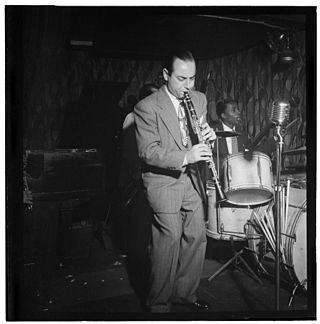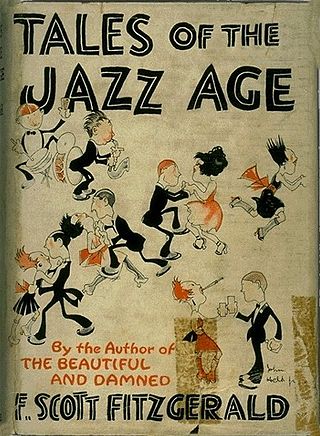Related Research Articles

Albert Edwin Condon was an American jazz banjoist, guitarist, and bandleader. A leading figure in Chicago jazz, he also played piano and sang.
Frank Teschemacher was an American jazz clarinetist and alto-saxophonist, associated with the "Austin High" gang.

Ben Pollack was an American drummer and bandleader from the mid-1920s through the swing era. His eye for talent led him to employ musicians such as Benny Goodman, Jack Teagarden, Glenn Miller, Jimmy McPartland, and Harry James. This ability earned him the nickname the "Father of Swing".

Lawrence "Bud" Freeman was an American jazz musician, bandleader, and composer, known mainly for playing tenor saxophone, but also the clarinet.

Robert Sage Wilber was an American jazz clarinetist, saxophonist, and band leader. Although his scope covers a wide range of jazz, Wilber was a dedicated advocate of classic styles, working throughout his career to present traditional jazz pieces in a contemporary manner. He played with many distinguished jazz leaders in the 1950s and 1960s, including Bobby Hackett, Benny Goodman, Sidney Bechet, Jack Teagarden and Eddie Condon. In the late 1960s, he was an original member of the World's Greatest Jazz Band, and in the early 70s of Soprano Summit, a band which gained wide attention. In the late 1970s, he formed the Bechet Legacy Band.

Michael Andrew "Peanuts" Hucko was an American big band musician. His primary instrument was the clarinet, but he sometimes played saxophone.
Friar's Inn was a nightclub and speakeasy in Chicago, Illinois, a famed jazz music venue in the 1920s.
James Dugald "Jimmy" McPartland was an American cornetist. He worked with Eddie Condon, Art Hodes, Gene Krupa, Benny Goodman, Jack Teagarden, and Tommy Dorsey, often leading his own bands. He was married to pianist Marian McPartland.

Dave Tough was an American jazz drummer associated with Dixieland and swing jazz in the 1930s and 1940s.

Michael Joseph O'Sullivan was an American jazz pianist.
Dick McPartland was a jazz guitarist during the 1920s and the older brother of Jimmy McPartland. He was part of the Austin High School Gang of musicians in Chicago.

Elmer "Mousey" Alexander was an American jazz drummer.
Leonard Gaskin was an American jazz bassist born in New York City.
Jim Lanigan was an American jazz bassist and tubist.
Charles Coleridge "Red" Richards was an American jazz pianist.
McKenzie and Condon's Chicagoans was an American jazz band from Chicago, led by banjo player Eddie Condon and sponsored by singer and comb player Red McKenzie. Their four recordings in December 1927 were important influences on early Chicago style jazz.

Austin College and Career Academy High School is a public four-year high school located in the Austin neighborhood in Chicago, Illinois, United States. Operated by the Chicago Public Schools, Austin opened in 1876 and was named in honor of Henry W. Austin, a Chicago real estate developer. Austin shared its campus with two smaller schools; Austin Business & Entrepreneurship Academy High and V.O.I.S.E. Academy High School. After the 2015–2016 school year, the small schools converted into one school and was renamed Austin College and Career Academy High School.

The period from the end of the First World War until the start of the Depression in 1929 is known as the "Jazz Age". Jazz had become popular music in America, although older generations considered the music immoral and threatening to cultural values. Dances such as the Charleston and the Black Bottom were very popular during the period, and jazz bands typically consisted of seven to twelve musicians. Important orchestras in New York were led by Fletcher Henderson, Paul Whiteman and Duke Ellington. Many New Orleans jazzmen had moved to Chicago during the late 1910s in search of employment; among others, the New Orleans Rhythm Kings, King Oliver's Creole Jazz Band and Jelly Roll Morton recorded in the city. However, Chicago's importance as a center of jazz music started to diminish toward the end of the 1920s in favor of New York.

This is a timeline documenting events of Jazz in the year 1922.
The Chicago Rhythm Kings was the name under which the recordings of several different jazz ensembles were issued. The earliest of these was a jazz octet consisting of vocalist Red McKenzie, cornetist Muggsy Spanier, saxophonist Frank Teschemacher, guitarist Eddie Condon, clarinetist Mezz Mezzrow, pianist Joe Sullivan, drummer Gene Krupa, and bassist and tubist Jim Lanigan. This group, who also recorded under the name the Jungle Kings, released a 1928 record for Brunswick Records as the Chicago Rhythm Kings performing Benton Overstreet's "There'll Be Some Changes Made" and Jack Palmer and Spencer Williams's "I Found a New Baby".
References
- ↑ Gridley, Mark C. Jazz Styles: History and Analysis. Addison Wesley Longman, 9th ed., 2005. Print.
- 1 2 "The Austin High Gang." Redhotjazz.com. Accessed June 26, 2015. <http://www.redhotjazz.com/austinhighgang.html Archived 25 November 2017 at the Wayback Machine >
- 1 2 3 Smith, Charles Edward. “The Austin High Gang.” Jazzmen. Harcourt, Brace and Company, 1939. Print.
- 1 2 "Jazz Crazed: The Story of the Austin High Gang." Riverwalk Jazz. Accessed June 26, 2015. <http://riverwalkjazz.stanford.edu/program/jazz-crazed-story-austin-high-gang>
- ↑ "Bud Freeman – Chicago / Austin High School Jazz In Hi-Fi." http://www.discogs.com/Bud-Freeman-Chicago-Austin-High-School-Jazz-In-Hi-Fi/master/393715